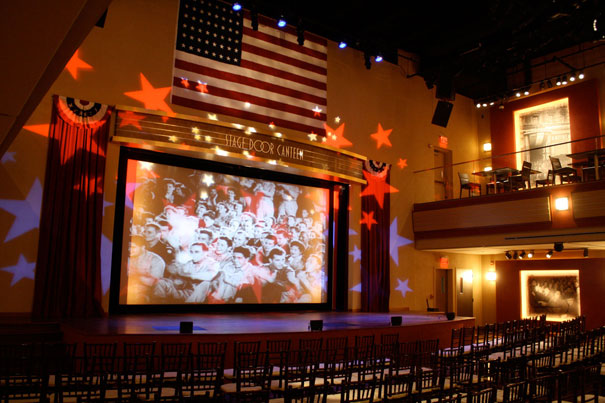National WWII Museum, New Orleans, LA
Date Posted: 6/3/2010

The National World War II Museum's new 70,000-square-foot $60-million complex, comprised of The Solomon Victory Theater, Stage Door Canteen, and The American Sector restaurant opened November 6, 2009, part of the Museum's $300-million expansion. All three venues depend on ETC lighting and control gear to provide a compelling guest experience.
The 250-seat Victory Theater presents the 40-minute, 4-D cinematic experience entitled Beyond All Boundaries. The automated theatrical presentation system relies on an ETC Ion® control console, ETC Net3™ data distribution, ETC dimming, and some 400 Source Four® fixtures. In addition to cueing the lighting network, the Ion has the ability to interconnect to an extensive range of equipment via serial RS232. The ETC system integrator was Bandit Lites, working to specifications by production-design firm Visual Terrain.
Timing and sequencing are key to making
Beyond All Boundaries
unfold with dramatic precision. In-theater effects include choreographed searchlight sequences using fixtures with gobo rotators tied to custom profiles, a simulated nuclear explosion created with sound and strobes, and weather effects including snow and wind. The Ion console was selected for its ability to provide high-level control of automated systems and integrate easily with other systems. "This show is a fusion of theatrical design and themed entertainment," says Michael Mahlum, senior designer with Visual Terrain. "We were looking for well-rounded programming ability and quick adjustments. The Ion can handle the conventional fixtures as well as the sophisticated automated gear."
"We try to bring ETC along whenever it makes sense on a project," says Lisa Passamonte Green, principal of Visual Terrain. "We turn to them because of their excellent support, service, and of course, their technology."
The Ion console does double duty in the museum's Stage Door Canteen, a small, versatile dinner theater that hosts a variety of live and pre-recorded entertainment. The canteen is styled after the 1940s wartime venues that entertained the troops in large American cities during the war.
"It had to be a flexible space in that there were canned shows as well as rental situations," says project designer Ted Mather, managing principal of lighting-design firm Available Light, New York. "We needed a system that could handle all the show control needs, and if somebody rented the hall, have a console that a local designer could easily work with. The Ion is simple and straightforward but also has the power to do lighting color changes and automated fixtures. And the museum staff only needs to know the one console."
The theater-lighting package uses numerous ETC Source Four fixtures, with Net3 control. An ETC Unison® Paradigm® architectural lighting system interfaces with all the control stations and houselighting in the Stage Door Canteen. Unison also handles the American Sector Restaurant in the same building.
Increasingly, museums are incorporating sophisticated theatrical systems (such as in the Solomon Victory Theater and Stage Door Canteen), to good effect: The National World War II Museum recently reported that since the November opening of the Victory Theater, attendance has grown to almost triple the museum's numbers for the same period a year earlier.
The availability of technical service was also a factor in the selection of equipment. "I knew that in New Orleans they would be able to get support for the ETC products," says Mather. "So far, I have never come across a place where you couldn't get local ETC support."